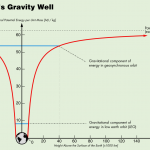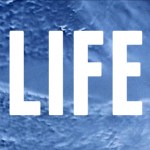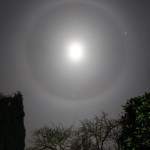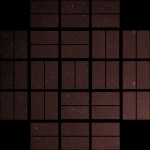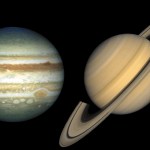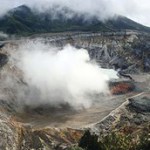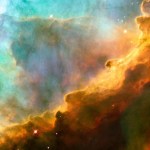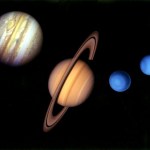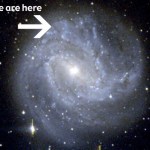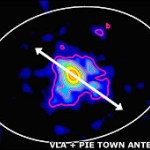Jupiter
On Life Lines, Dr. Dolittle examines the fascinating parallels between hummingbird and insect flight. He and/or she writes: "The researchers placed nontoxic paint on the wing of a ruby-throated hummingbird at 9 different spots then videotaped the animal flying at 1,000 frames per second with 4 cameras simultaneously." Despite being far removed from insects on the phylogenetic tree, hummingbirds "stir up air around their wings in a way similar to insects like mosquitoes and dragonflies." This is an example of convergent evolution, as natural selection engineers similar solutions for very…
"Even in hindsight, I would not change one whit of the Voyager experience. Dreams and sweat carried it off. But most of all, its legacy makes us all Earth travelers among the stars." -Charley Kohlhase
In the early days of space exploration, it was quite a feat just to get up and out of Earth's atmosphere. There's are two good, simple reason for that, of course: first, it takes a lot of energy to go up that high...
Image credit: Nathan Bergey of http://psas.pdx.edu/orbit_intro/.
and second, if you don't get your spacecraft moving really fast, you're just going to fall back to…
Discovery, by nature, has a ripple effect. When one thing is found to be plausible, testable, or true, a suite of potential other truths and plausibilities tend to follow suit. This is the nature of inductive reasoning, the foundation of the scientific method, and the reason why science–as a human project–is generational. We discover something unexpected, and we celebrate twofold, threefold, and morefold, because its nuances and implications can ebb outwards, often lending hope to scientists working in entirely different fields.
Take the recent discovery of life in Lake Vostok, for instance:…
"Tell me what you feel in your room when the full moon is shining in upon you and your lamp is dying out, and I will tell you how old you are, and I shall know if you are happy." -Henri Frederic Amiel
Tonight is a special night, although not for the reasons you may think. Yes, it's just a few days after Christmas and before the new year, but tonight is the night of the Full Moon closest to the winter solstice.
Image credit: Judy Stone-Goldman.
Up here in the northern hemisphere (above the Tropic of Cancer), December 21st corresponds to the winter solstice, or the shortest day in…
"This one will look like a jellybean," the session director warns us. "Or, you know, when you empty a hole punch? The circles of paper that fall out? One of those." She's talking about Neptune, and I am about to step, carefully, up a ladder painted industrial yellow and wheeled into place in front of the centenarian eyepiece of the 60" Hale telescope at Mt. Wilson Observatory, incidentally the very place where Edwin Hubble, in 1925, discovered that our galaxy was not the entirety of the Universe, and later, that our Universe was expanding.
A jellybean, a piece of confetti: it seems her…
"Don't go around saying the world owes you a living. The world owes you nothing. It was here first." -Mark Twain
So, you've been around a while, seen all sorts of things, and learned an awful lot about the world, solar system and Universe that we live in. But how well do you know it, really?
Image credit: NASA / Lunar and Planetary Laboratory.
To scale and in order, these are the eight planets you know so well. There are the four rocky worlds of our inner solar system: Mercury, Venus, Earth, and Mars, and the four gas giants that dominate the outer solar system: Jupiter, Saturn, Uranus, and…
By Dr. Ignacio Mosqueira, an astrophysicist at the Carl Sagan Center for the Study of Life in the Universe, SETI Institute, and Gail Jacobs
Ignacio Mosqueira works with Paul Estrada to piece together the way in which giant planets - such as Jupiter and Saturn -- and their moons and rings formed. Ignacio notes that making moons is similar to forming planets. Understanding moons may have something to tell us about the possible habitats for life, since large moons could, in principle, have both the liquid water and atmosphere necessary for the kind of diverse biology we see on planet Earth.…
By Dr. Paul EstradaPlanetary physicist at the Carl Sagan Center for the Study of Life in the Universe, SETI Institute, and Gail Jacobs
If planets are a dime a dozen, moons are less than a penny each. There are at least 139 moons just within our own solar system. Most of these are the property of the gas giant planets beyond Mars. More than just a nice accompaniment to planets, moons may have habitats in which liquid water could ebb and flow - and possibly be a suitable home for life. Planetary physicist Dr. Paul Estrada investigates how moons around gas giants are formed -- an important…
By Dr. Cynthia Phillips
Planetary geologist at the Carl Sagan Center for the Study of Life in the Universe, SETI Institute
Jupiter's moon Europa could be the best place beyond the Earth to search for life. This small moon, about the size of Earth's Moon, is one of the Galilean moons first discovered 400 years ago by Galileo. The Galilean moons were the first objects observed to orbit another planet, and they revolutionized the way our solar system was understood.
Today, the moons of Jupiter are known to be a scientifically rich part of our solar system, and they are yielding a new revolution…
by Nathalie A. Cabrol
I realize how immodest the title of this first blog may sound and it is certainly not my intention to convince anybody that I will answer this question in the limited space allowed here or even in a lifetime. My hope is, instead, to stir thoughts and invite an exchange of diverse perspectives to make this a thread that we can all pull from time to time. It is an immense subject debated in an abundant literature, but discussing it is certainly not the exclusive privilege of those called explorers. All beings, from the greatest minds to the simplest forms of life on this…
There are plenty of examples in the music world where a cover of a song is strikingly different from the original and still interesting. Take the song You Spin Me Round, which cracked the top 5 all over Europe and North America when Dead or Alive released it. (Click for video.) 15 years later, Dope released a cover of the song in a completely different style, with an incredibly different feel. Take a listen:
It's a pretty good cover. It's interesting to listen to, it's decidedly different from the original, and it's still instantly recognizable. But by time I get to the end of the…
I'm always happy to receive questions from those of you interested enough to ask them, and every once in a while one of them feels just right to write up an article about it. Today's comes from Brad Walker, who asks about the inside of gas giants. Specifically,
The question pertains to the insides of gas giants like Jupiter... My question is, supposing Jupiter is made of Metallic Hydrogen, and it was dragged close enough to the sun that its atmosphere evaporated, what would be left? How would it go from a very strange non-terrestrial core to a rocky body like CoRoT-7b? Why wouldn't the…
Can you believe that I had a fight today with someone who's been dead for over 350 years, and I'm losing? -- Ethan, yesterday
Of course you can believe it, when the man I'm fighting with is Johannes Kepler. I don't get a chance to tell you about my research very often, mostly because it's still a work in progress. But my latest paper was just submitted and is now out of the way, and so I'd like to tell you what I'm working on at the moment.
Well, there we are in the galaxy. We look up at the night sky, and we see our planets as well as all the stars that surround us. But you know what we don…
Starts with a bang reader Dumb Ass Dave points us to this BBC article about the discovery of a planet that's only just forming around a new star. The planet is surely less than 100,000 years old, although the 1,600 year old figure quoted in the article is probably hogwash.
How do you find it? Take a look at this picture below, taken in radio waves:
That big blurry thing in the center? That's a newly forming star, with a proto-planetary disk around it. But see that little blob in the upper right? That's a planet forming up there! When they do their analysis and determine its mass, it turns…

